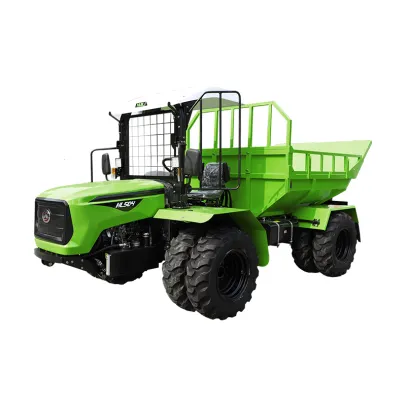How to choose an orchard tractor according to the use environment
Aug. 12, 2024
Different categories and varieties require different planting patterns and different agronomic requirements. Even "scaled + standardized" orchards have personalized needs for agricultural machinery, so choosing one requires a keen eye.
Theoretically, any orchard that can be entered by a machine can use an orchard tractor, but if it is divided into subdivided use scenarios, the choice of orchard tractors is very particular.
Choices for old orchards: unmanned driving, remote control, side driving, two-way driving
Traditional old orchards still account for the vast majority. The data obtained by the author from the Guanzhong area of Shaanxi shows that standardized orchards only account for 10%, and the rest are still all old orchards.
The biggest problem with old orchards for agricultural machinery is that the use of agricultural machinery was not considered at all when the orchard was built.
In 2015 and 2016, I visited more than 50 citrus orchards, kiwi orchards, lemon orchards, and vineyards. It can be said that almost all of them are traditional planting models - tree-like, dwarfing, and dense planting. Except for micro-tillage machines, backpack-type, and pull-tube sprayers, other agricultural machinery cannot enter the land. Therefore, agricultural machinery companies such as Master have developed remote-controlled crawler orchard tractors specifically for old orchards.
At present, many places are carrying out mechanized transformation of old orchards, and old orchards give priority to unmanned, remote-controlled, side-driving, and two-way driving tractors.

Choices for mountain orchards: crawler, heavy chassis, and bending steering
The current national crop planting policy is that fruits and vegetables do not compete with grains for land. Some areas such as Shaanxi, Shandong, and Sichuan, where fruit planting is concentrated, have begun to "return fruit to the field". A large number of low-yield and low-quality old orchards have dug up fruit trees and resumed planting wheat and corn. For a long time in the future, orchards will be built on the "four wastelands", that is, waste mountains, waste ridges, waste slopes, and waste beaches.
The golden age of the orchard industry has passed, and the conditions for building orchards will be very challenging in the future. To achieve large-scale planting and mechanization, we must find orchard machinery suitable for the "four wastelands".
Specifically, in terms of the choice of tractors, mountain orchards should give priority to heavy chassis, low center of gravity, crawler and folding waist steering orchard tractors.
Further reading:Three characteristics of orchard tractors
Folding waist steering tractors, also known as articulated tractors. This type of tractor has a heavy chassis, a low center of gravity, and a reasonable front and rear weight distribution, which is most suitable for hilly and mountainous orchard operations.
Choices for facility orchards: low-profile, greenhouse king, electric orchard machine, two-way driving
Fruit tree facility cultivation refers to the use of greenhouses, plastic greenhouses, rain shelters and other protective facilities in seasons (regions) that are not suitable for the growth and development of fruit trees. On the basis of making full use of local natural resources, it improves or controls environmental factors such as light, temperature, humidity and carbon dioxide concentration in the facilities, provides suitable environmental conditions for the growth and development of fruit trees, and then achieves production goals. The artificial adjustment cultivation mode is a highly capital, labor and technology-intensive industry.
Facility orchards are a new form of business in China. At present, facilities have begun to be used in the planting of high-end grapes, apples, citrus, pitaya, avocado, passion fruit and other fruit trees.
The cultivation of fruit trees from open air to trellises and greenhouses will also bring new problems in the matching of agronomy and agricultural machinery. The use of environmental standards in facility greenhouses is standardized, but the working space will become narrow and cramped. Such an environment requires a tractor with a lower center of gravity and a shorter wheelbase, and it is best to be equipped with a two-way driving function.
Therefore, facility orchards should give priority to low-profile, greenhouse king, electric orchard machines, and two-way driving tractors.
Standardized orchard selection: high power and high efficiency, standard tractors
At present, many investors choose the standard planting mode for new large-scale orchards. The author once wrote an article introducing the case of a 300-acre standardized citrus orchard in Jiangxi.
The orchard adopts two modes: one is large seedling planting, with a row spacing of 5 meters and a plant spacing of 1.2 meters; the other is a more typical hedge planting mode, which can be imagined as trimming the trunk and crown branches into a wall, like the shrub hedge belt in the urban green belt, not allowing the branches to grow to the sides, but to grow upward. The orchard hedge frame cultivation row spacing is 5 meters, the plant spacing is 0.6 meters, and the main trunk is limited to about 2.5 meters.
For orchards with a row spacing of 3-5 meters, standard tractors below 100 horsepower and orchard-specific tractors can be used, so following standardized planting is not too picky about agricultural machinery. This kind of garden is recommended to use a high-efficiency orchard tractor with 70 horsepower or above
74
0
0
All Comments (0)
Previous: None
If you are interested in sending in a Guest Blogger Submission,welcome to write for us!


Comments